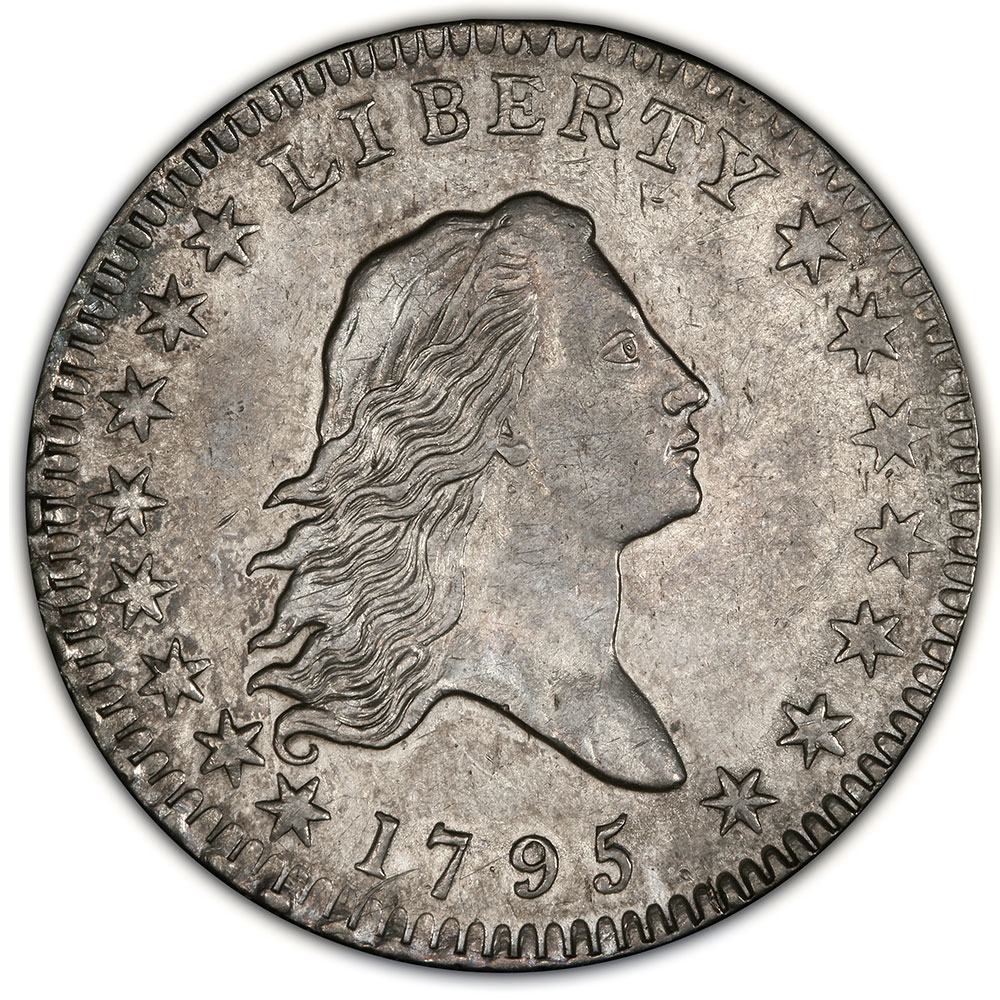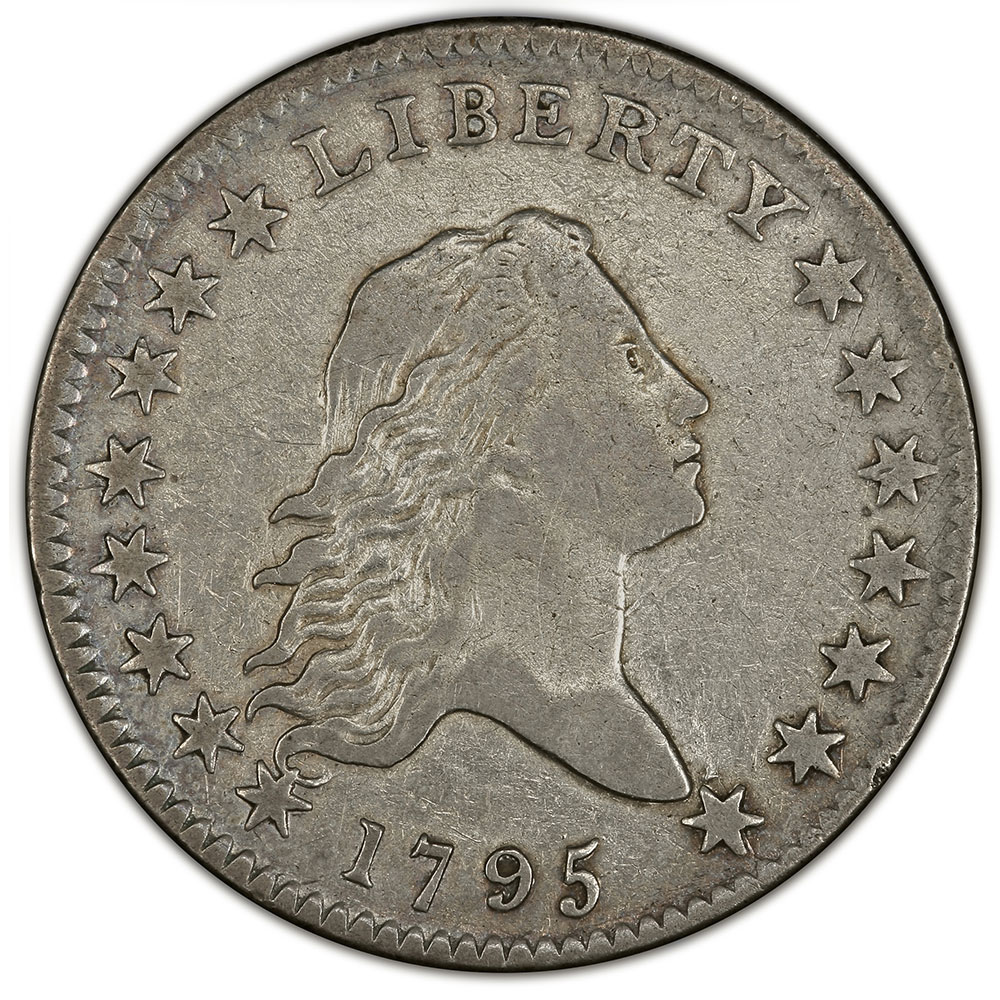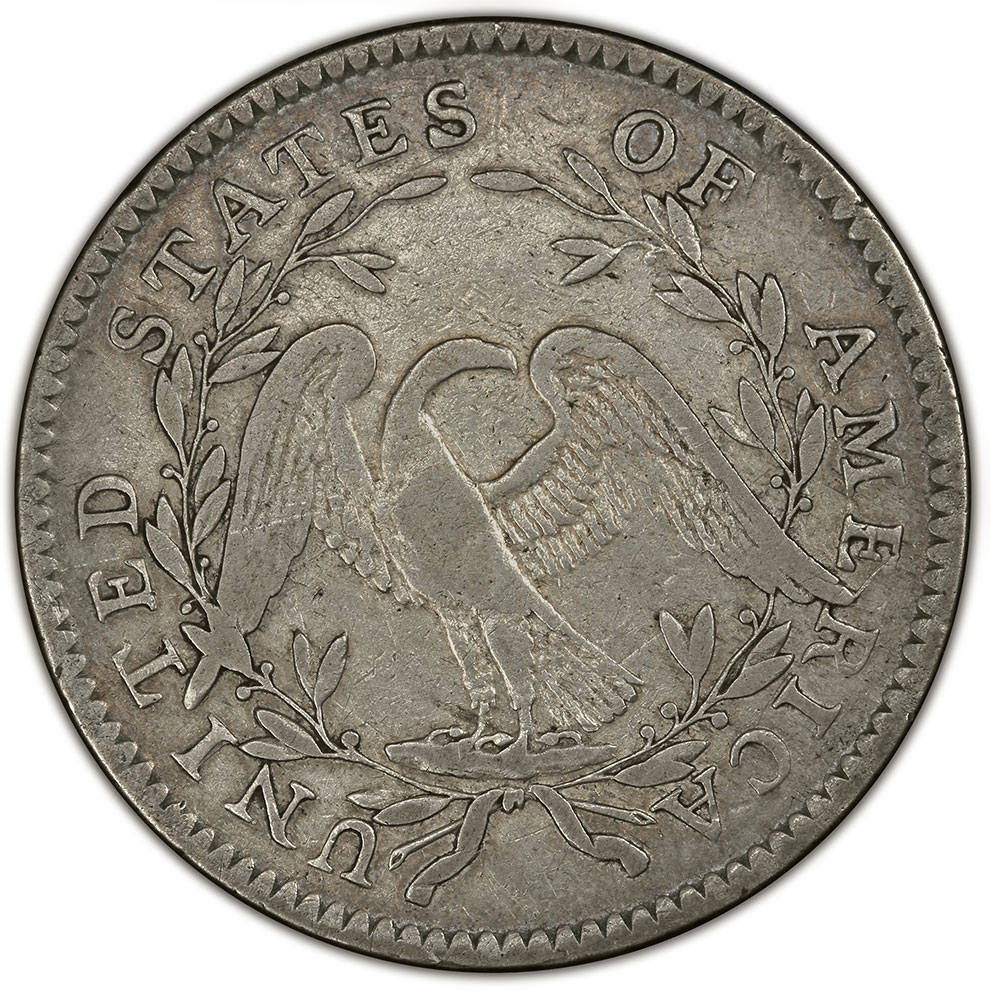
Coin Snapshot
- Weight: 13.48 grams
- Composition: 89.24% silver, 10.76% copper
- Diameter: 32.5 mm
- Thickness: 2.2 mm
- Years Minted: 1794-1795
- Designed by: Robert Scot
- Total Coins Struck: 23,464 (combined total for 1794 and 1795)
Brief Overview of the Flowing Hair Half Dollar
The Flowing Hair Half Dollar, minted from 1794 to 1795, holds the distinction of being the first official half dollar issued by the United States Mint. This coin, designed by Robert Scot, features a depiction of Liberty with flowing hair, symbolizing the youthful freedom of the new nation. The reverse showcases a small eagle encircled by a wreath, representing the country’s strength and unity. Though the series was short-lived, its significance in the early history of U.S. coinage has made the Flowing Hair Half Dollar highly sought after by collectors.
With a mintage of just over 23,000 coins across two years, surviving examples are quite rare today. The Flowing Hair design was quickly replaced by the Draped Bust series in 1796, but its place as a foundational piece of American numismatics has cemented its legacy. Though maybe not as popular as the Flowing Hair Dollar, it is still highly collectible in its own right. Due to its age, rarity, and historical importance, the Flowing Hair Half Dollar commands high premiums at auction, particularly in well-preserved condition.
Flowing Hair Half Dollar Coin Design
Though it may not be the most recognizable coin design ever made, the Flowing Hair Half Dollar is certainly one of the most iconic and historically significant coins ever minted. As the first US Half Dollar coin officially produced by the United States, it is an important part of American history.

Obverse Design
The obverse of the Flowing Hair Half Dollar was designed by Chief Engraver Robert Scot. It features Scot’s side-profile depiction of Lady Liberty with her hair flowing behind her, symbolizing the spirit of liberty and the newfound freedom of the United States. The word “LIBERTY” is inscribed above her head, and 15 stars (representing the number of states in the Union at the time) surround the design. The date of minting (which is either 1794 or 1795) appears below Liberty’s portrait.
The Flowing Hair design is emblematic of early American coinage and represents the country’s transition from British colonial rule to total freedom and independence. This design was the first ever used on U.S. silver coinage, including the dollar and half dollar, marking a significant moment in the nation’s monetary history.

Reverse Design
The reverse of the Flowing Hair Half Dollar features a small eagle, perched on a rock and surrounded by an olive branch and a wreath. The olive branch symbolizes peace, while the eagle represents the strength and sovereignty of the United States. The inscription “UNITED STATES OF AMERICA” encircles the design along the rim, with no denomination indicated, as was common in early U.S. coinage.
This small eagle reverse design was used on multiple denominations during the early years of the U.S. Mint but was quickly replaced by a more robust heraldic eagle in later years. Despite its brief use, the small eagle design remains a favorite among collectors for its simplicity and historical significance.
Mint Locations and Mintmarks on the Flowing Hair Half Dollar
The Flowing Hair Half Dollar was minted exclusively at the Philadelphia Mint, which was the only U.S. Mint in operation at the time. As such, no mintmark is present on the coin, as was typical for coins produced in Philadelphia during the early years of the Mint’s existence.
The fact that all Flowing Hair Half Dollars were struck in Philadelphia makes these coins even more historically significant, as they represent some of the first silver coins produced by the fledgling U.S. Mint. The early minting processes were primitive by today’s standards, and many surviving examples show uneven strikes or other imperfections, which adds to their appeal for collectors of early American coinage.
History of the Flowing Hair Half Dollar
The Flowing Hair Half Dollar was born out of the need to establish a standardized national currency following the ratification of the U.S. Constitution. Prior to the establishment of the U.S. Mint in 1792, much of the circulating currency in the United States consisted of foreign coins, making a national coinage system a priority for the new government.
In 1792, Congress passed the Coinage Act, which authorized the establishment of the U.S. Mint and the production of coins in various denominations, including the half dollar. The Flowing Hair design, created by Robert Scot, was used on the first silver coins issued by the Mint, including the dollar, half dollar, half dime, and quarter.
The first Flowing Hair Half Dollars were struck in 1794, with a total mintage of just 23,464 coins across the two years of production (1794 and 1795). The coin was quickly replaced by the Draped Bust design in 1796, which featured a more refined depiction of Liberty and a heraldic eagle on the reverse.
Despite its short production run, the Flowing Hair Half Dollar holds a special place in U.S. numismatic history as the first half dollar coin ever produced by the U.S. Mint. Its scarcity, combined with its historical importance, has made it one of the most desirable coins among collectors of early American coinage.
Rarity and Value of the Flowing Hair Half Dollar
Due to its limited production and age, the Flowing Hair Half Dollar is quite rare today. While over 23,000 were originally minted, the number of surviving examples is far smaller, particularly for the 1794 issue, which had a mintage of only 5,300 coins. The 1795 version had a larger mintage, but both years are considered rare, especially in higher grades.
Prices for Flowing Hair Half Dollars vary widely based on condition. Circulated examples in lower grades can sell for tens of thousands of dollars, while higher-grade coins, particularly those in mint state, can reach six-figure sums at auction. Well-preserved examples with sharp details and minimal wear are highly sought after by collectors of early American coinage.
The rarity and historical importance of the Flowing Hair Half Dollar make it one of the most valuable coins from the early U.S. Mint, with prices continuing to rise as more collectors seek to acquire this iconic piece of American history.
Examples of Rare and Expensive Flowing Hair Half Dollars
- 1794 Flowing Hair Half Dollar: As the first half dollar ever minted in the United States, the 1794 Flowing Hair Half Dollar is extremely rare and valuable. High-grade examples can sell for hundreds of thousands of dollars.
- 1795 Flowing Hair Half Dollar (Mint State): While more common than the 1794 issue, mint state examples of the 1795 Flowing Hair Half Dollar are highly prized by collectors. These coins can fetch six-figure prices at auction due to their rarity and historical significance.
Flowing Hair Half Dollar Condition and Certification
Given the age and rarity of the Flowing Hair Half Dollar, certification by professional grading services such as PCGS or NGC is essential for buyers and sellers alike. Certified coins come with an assurance of authenticity and an accurate assessment of the coin’s condition, which is particularly important for such valuable pieces.
Flowing Hair Half Dollars that are graded in Very Fine (VF) or higher are particularly desirable. Even in lower grades, the historical importance of these coins makes them valuable, but higher-grade examples with well-preserved details and minimal wear can command significantly higher prices. Certification also helps protect buyers from counterfeit coins, which is always a risk when dealing with rare and valuable pieces.
Buying Flowing Hair Half Dollars Online
For collectors looking to purchase a Flowing Hair Half Dollar, online auctions and specialized coin dealers are the best sources. Reputable auction platforms such as Heritage Auctions and Stack’s Bowers Galleries frequently offer Flowing Hair Half Dollars in various grades, from lower-grade circulated coins to rare mint state examples.
When purchasing a Flowing Hair Half Dollar online, it is important to ensure that the coin has been certified by a trusted third-party grading service. Certified coins provide buyers with peace of mind regarding the coin’s authenticity and condition. Collectors should also consider the coin’s provenance, as coins with well-documented histories tend to be more valuable.
Given the rarity and high value of Flowing Hair Half Dollars, these coins are typically sought after by experienced collectors. However, for those with a deep appreciation for American history and numismatics, acquiring a Flowing Hair Half Dollar represents a significant and rewarding addition to any collection.
